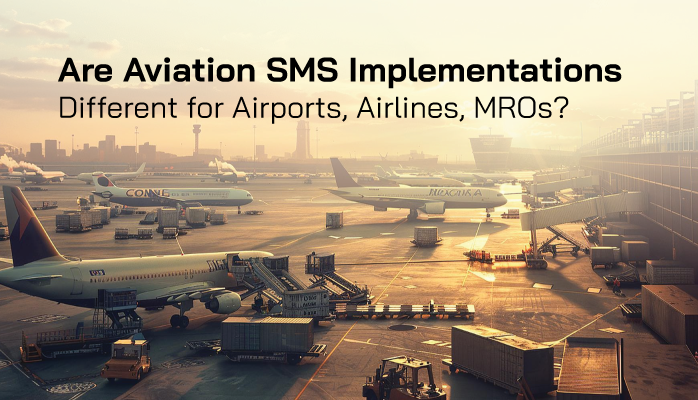Airport SMS vs Airline SMS Implementations

Surprisingly, we receive questions about “airline SMS programs” and “airport SMS programs” all the time, as if they were two entirely different species of aviation SMS.
I get the feeling that the question of airport SMS vs airline SMS arises from misinterpreting what aviation safety management systems (SMS) are.
In three lines, aviation SMS implementations are:
- Formal bureaucratic processes to identify and mitigate risk;
- Designed to quantify and qualify risk management practices; and
- A marriage of positive safety culture with efficient safety policy with the goal of continuous improvement.
Related Aviation SMS Implementation Articles
- Why Should We Implement Aviation SMS?
- How to Complete Phase 1 of Aviation SMS Implementation [With Free Checklist]
- Is Your Aviation SMS Implementation a Farce? - With Self Assessments
Looking at aviation SMS like this, it should become immediately obvious that SMS' risk management processes could be used anytime and anywhere, whether in the aviation industry, biochemical industry, or on an extended backpacking adventure. The fundamental principles and process are the same for
- Identifying hazards;
- Reporting safety issues;
- Managing safety issues;
- Implementing risk controls; and
- Reviewing implemented controls.
Period. End of story.
Yet modern aviation SMS is not like traditional safety programs. This is not the point. The point is that risk management processes for airlines and airport SMS will be just as effective. The context shifts a bit from the type of safety events that occur based on the operator's mission.
Aviation SMS Tools for Airports vs Airlines

Fundamental principles aside, SMS implementations will be utilized in subtly different ways in airports and airlines – hence the confusion about whether the SMS is different. Once again, however, the difference is not so much in the SMS itself as in the difference of which tools and types of concerns are stressed. In other words, the same style of shoes, different colors.
Certain resources will be a mainstay in both airlines and airports, like backbone SMS tools such as processes for
- Hazard identification;
- Safety reporting;
- Hazard management;
- Hazard risk register and risk controls;
- SMS auditing; and
- Gap analysis.
These kinds of tools are the backbone of modern-day SMS and will be widely and frequently used in both airline SMS and airport SMS. Along with these tools, the duties and responsibilities of employees, management, and the safety department should also be largely the same.
In both types of SMS, department heads will remain subject-matter experts and process owners in assigning corrective preventative actions (CPAs). Employees will still be relied upon for identifying and reporting safety issues. Major SMS processes and how employees view their roles/responsibilities account for a vast majority of the success and makeup of an SMS. It’s only in the extremities and details that we see a couple of differences in how airline and airport SMS functions.
Related Aviation Risk Management Articles
- How to Practice Reactive, Proactive, and Predictive Risk Management in Aviation SMS
- 4 Elements of Safety Risk Management (SRM)
- Best Safety Risk Management Practices for Aviation Maintenance
How Airport SMS and Airline SMS Are Unique
In the nitty-gritty details of Airport SMS, there will be a couple of thematic differences in the tools used. Let’s look at a couple. The first difference you would expect to see between both SMS would be the utilization of operation-specific tools such as:
- Flight Risk Assessment (FRAT);
- Pilot Duty;
- Applicable Regulations;
- Policies and Procedures;
- Risk Analysis Charts; and
- Probably most importantly, Key Performance Indicators (KPIs).
Hopefully, it’s fairly clear why the above aviation SMS tools would be different for airlines' and airports' SMS. Airports have little need for tools like FRAT or Pilot Duty. Regulations for airports and airlines are obviously different. Thus, both Policies and Procedures and KPIs will reflect those operational differences as well. Moreover, specific Risk Analysis Charts should be the same for both airlines and airports, but some charts will ideally reflect safety data that is specific to airports or airlines.
I can’t stress this enough, though, that the above differences are superficial, as they are still guided by the same underlying SMS goals, SMS risk management processes, and – perhaps most to the point: aviation SMS structure.
Start Your Aviation SMS on the Right Foot
Safety managers need to understand this difference when implementing their SMS. Imagine a not-uncommon scenario, where a smaller airline or airport assigns one of their workers the title of safety manager. This person may know next to nothing about SMS, and if they begin researching to implement an “airport-specific” or “airline-specific” SMS, then they run the risk of running down an easily avoided rabbit hole.
Starting on the right foot means:
- Realizing that SMS for airports and airlines is guided by the same underlying principles, structure, and primary tools; and
- Acquiring SMS tools BEFORE dictating SMS processes.
Following these points would ideally illuminate the important point that SMS follows a universal structure, with minor differences in stress depending on the organization's operational complexity and size.
If you are just starting your SMS program or reviewing an existing SMS implementation, the following checklists will be valuable.
Starting an aviation SMS? If you don't already have defined risk management processes, adopting a low-cost, commercially available SMS database early is a best practice. When you choose an SMS database, you should expect to tailor the workflow to meet your needs. If you need an SMS manual and an SMS database at the same time, check out SMS Pro. We can help.
If you are wondering about effective risk management workflows, we offer a glimpse into those used by SMS Pro.
Last updated July 2025.








